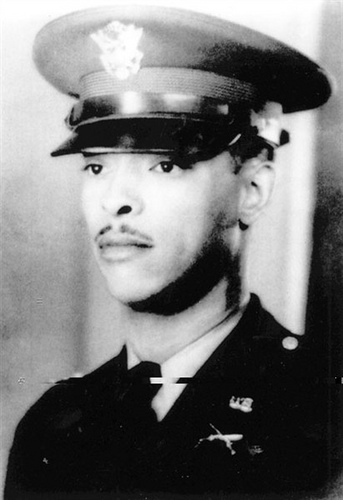
First Lieutenant John R. Fox
 First Lieutenant John Robert Fox was killed in action when he deliberately
called for artillery fire on his own position, after his position was overrun,
in order to defeat a German attack in the vicinity of Sommocolonia, northern
Italy during World War II.
First Lieutenant John Robert Fox was killed in action when he deliberately
called for artillery fire on his own position, after his position was overrun,
in order to defeat a German attack in the vicinity of Sommocolonia, northern
Italy during World War II.
A native of Cincinnati Ohio John Fox was born May 18, 1915.
Fox was only 29 years old when he called artillery fire on his own position the day
after Christmas in 1944, for which he was posthumously awarded the Distinguished
Service Cross in 1982. More than fifty years after his death, Fox was awarded
the Medal of Honor. He is buried in Colebrook Cemetery in Whitman,
Massachusetts.
The 92nd Infantry Division, also known as the Buffalo Soldiers, was a segregated African American division that fought in World War II. First Lieutenant John R. Fox was of the 366th Infantry Regiment when he made the ultimate sacrifice in order to defeat the enemy and save the lives of his fellow soldiers. In December 1944, Fox was part of a small forward observer party that volunteered to stay behind in the Italian village of Sommocolonia, in the Serchio River Valley. American forces had been forced to withdraw from the village after it had been overrun by the enemy. From his position on the second floor of a house, Fox directed defensive artillery fire.
The enemy was in the streets and attacking in strength, greatly outnumbering the small group of American soldiers. Fox radioed in to have the artillery fire adjusted closer to his position, then radioed again to have the shelling moved even closer. The soldier receiving the message was stunned, for that would bring the deadly fire right on top of Fox’s position; there was no way he would survive. When Fox was told this, he replied, “Fire it.” This shelling delayed the enemy advance until other units could reorganize to repel the attack.
His action permitted U.S. forces, who had been forced to withdraw, to organize a counterattack and regain control of the village. After the units had retaken the village, they found Fox’s body along with the bodies of about one hundred enemy soldiers.
After the war the citizens of Sommocolonia, Italy erected a monument to nine men who were killed during the artillery barrage - eight Italian soldiers, and Lieutenant Fox.
In 2005, the toy company Hasbro introduced a 12-inch action figure "commemorating Lt. John R. Fox as part of its G.I. Joe Medal-of-Honor series.
First Lieutenant John R Fox's Citation reads:
Citation: For extraordinary heroism in action on 5 and 6 April 1945, near Viareggio, Italy. Then Second Lieutenant Baker demonstrated outstanding courage and leadership in destroying enemy installations, personnel and equipment during his company's attack against a strongly entrenched enemy in mountainous terrain. When his company was stopped by the concentration of fire from several machine gun emplacements, he crawled to one position and destroyed it, killing three Germans. Continuing forward, he attacked an enemy observation post and killed two occupants. With the aid of one of his men, Lieutenant Baker attacked two more machine gun nests, killing or wounding the four enemy soldiers occupying these positions. He then covered the evacuation of the wounded personnel of his company by occupying an exposed position and drawing the enemy's fire. On the following night Lieutenant Baker voluntarily led a battalion advance through enemy mine fields and heavy fire toward the division objective. Second Lieutenant Baker's fighting spirit and daring leadership were an inspiration to his men and exemplify the highest traditions of the Armed Forces.
Michael Arnold Art
-
Original signed acrylic paintings on canvas by award winning artist Michael Arnold. Beautiful selection of art for sale
michaelarnoldart.com
The Dog Encyclopedia-
Empowering information for pet owners to enhance and enrich a dog's life.
dogencyclopedia.org
Major General Charles F. Bolden, Jr. Corporal Buddie Branch Vice Admiral David L. Brewer III Rear Admiral Erroll M. Brown
Staff Sergeant Edward A. Carter, Jr. Brigadier General Roscoe C. Cartwright Rear Admiral Osie V. Combs
Four Star General Benjamin Davis Major General Arnold Fields Rear Admiral Lillian Fishburne First Lieutenant John R. Fox
Vice Admiral Samuel Gravely, Jr. Major General James F. Hamlet Harlem Hellfighters 4 Star General Daniel James Jr.
Private First Class Willy F. James, Jr. Corporal Harry Johns Major Robert H. Lawrence, Jr.
Staff Sergeant Aubrey L. McDade, Jr. Vice-Admiral Ed Moore Four Star General Lloyd W. Newton
Captain Joseph N. Peterson General Colin Powell Captain Ronald A. Radcliffe Admiral J. Paul Reason
Four Star General Edward A. Rice Jr. Staff Sergeant Ruben Rivers Clifford Chester Sims Robert Smalls
Major General Clifford L. Stanley Tuskegee Airmen Lieutenant Colonel Merryl (David) Tengesdal
Captain Charles L. Thomas Private George Watson Major General Leo V. Williams, III Colonel Charles Young
Alaskan Nature | |Floridian Nature | Free Holiday Ideas | Reflections | Michael Arnold Art
|